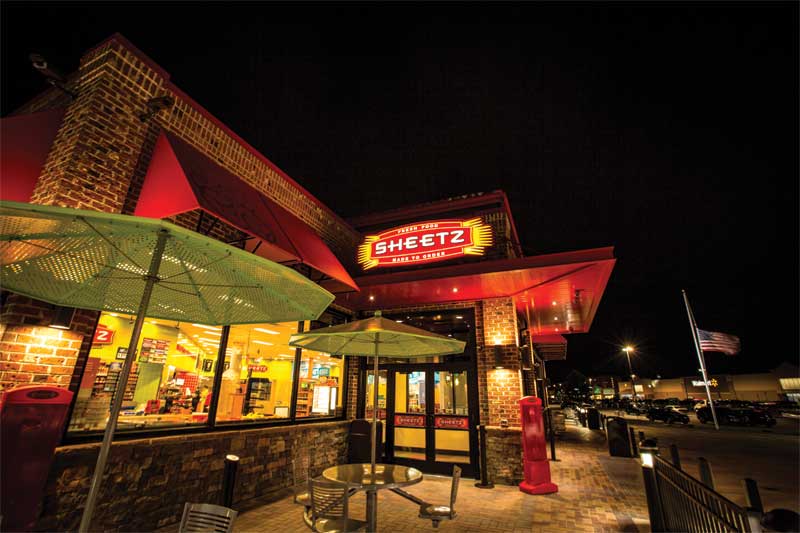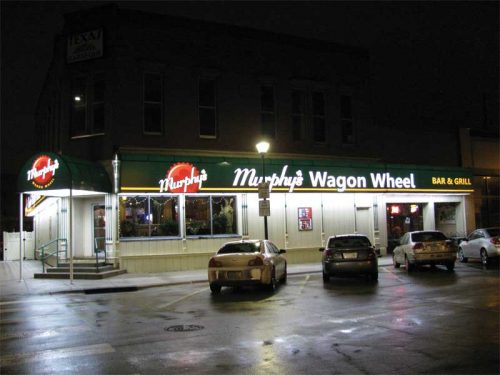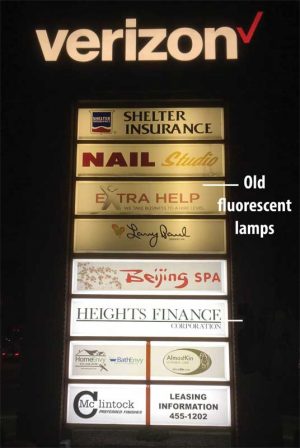Fluorescent-to-LED: How simple sticks reinvigorated the illuminated sign market
by | 6 September 2019 12:45 pm
By J. Bryan Vincent
 [1]
[1]Today, LED retrofits are in full swing in the sign industry as they are a cost-effective solution to existing light fixtures.
Just seven years ago, T12 was starting out in the light-emitting diode (LED) retrofit market. At the time, channel letter retrofits dominated the industry; however, the idea that a C$3 T12 could be retrofitted cost-effectively to an LED was a long shot and was exclusively reserved for high-maintenance locations. Regardless, the market was so big and ubiquitous that LED manufacturers and sign companies alike strove to come up with a solution. Early stage innovations included everything from rollout carpet products to various substrates with light bars that needed to be field assembled. Manufacturers were constantly experimenting through this nascent market.
Switching to a reliable power supply
 [2]
[2]With LEDs, the beams are more directional, which allows maximum sign illumination with a minimum number of light sources.
Today, LED retrofits are in full swing as they are a cost-effective solution to existing light fixtures. The transition toward installing and using retrofits started with two basic approaches.
- A patented stick was developed, which could fit into existing sockets, allowing installers to follow traditional relamping processes. This line of direct in-socket products initiated a solution that has now become the standard for retrofitting sign cabinets—from T12 lamps to LED. The product allows the LED-carrier substrate to fit directly into a T12 socket. Also, the power supply is separate. This means a highly reliable commercial power source is used compared to the low dependability of ‘self-ballasted’ LED drivers. Therefore, the product can be field cut and any range of LED strings/modules can be placed onto the substrate.
- The product was entirely assembled in North America, which allowed a range of colours, lamp lengths, outputs, and beam patterns to cover any sign cabinet size that could be delivered in a timely manner.
As with any innovation, these ideas were simple, yet effective, and set a new market opportunity into motion in the illuminated sign space. More importantly, retrofits allowed sign installation companies to add value to their services by upgrading customers’ existing fluorescent fixtures to LEDs. Additionally, the low costs of these sticks combined with the rising expenses for maintaining and servicing signs guaranteed a faster return on investment (ROI) for businesses that upgraded to LEDs. The returns were easy to measure, further lowering the risk to business owners.
Driving ROI to customers
When converting from T12 to LED, there are three key costs that drive the customer’s ROI.
Energy Savings
LEDs typically lower the overall energy consumption by 50 to 75 per cent. Single-sided cabinets offer the most savings, especially if a retrofit is used. Lamps provide 360-degree illumination; therefore, much of the light never gets translated to lux (used to measure the amount of light output in a given area—one lux is equal to one lumen/m2 [one lumen per 11 sf) on the sign face. With LEDs, the beams are more directional, which allows maximum sign illumination with a minimum number of light sources. The number of hours a sign is on, as well as its utility rate, will impact the overall energy savings.
Maintenance
One of the biggest drivers of ROI is maintenance. Relamping can be an expensive process—much of the cost is not in the lamps itself, but in the time and labour required to reach the site and perform the job. Since LEDs last much longer than high-output (HO) T12 fluorescent lamps, end-users experience a substantial reduction in service calls and ongoing operational costs.
Upfront costs
Upfront costs of materials and installation are a big component of ROI for sign companies.
These expenses can impact returns; therefore, it is important to include them in the calculation. One way to help the customer save money is to install the retrofit when servicing their lamps. One is already attending to a service call in this case, so the upfront costs only include materials and the additional time required to install the retrofit versus relamping.
Calculating ROI on retrofit installations
 [3]
[3]With LEDs, the beams are more directional, which allows maximum sign illumination with a minimum number of light sources.
Many LED manufacturers can provide an ROI calculator. The author’s company has a simple online calculator that provides a custom ROI to sign businesses, which they, in turn, can directly present to customers. It even allows professionals to adjust their material markup and input their installation costs. The output includes annual savings for the customer and an ROI given over a specific time period.
There are three key variables that should be researched prior to bidding a T12-to-LED retrofit.
Evaluate the site
Sign professionals should begin by asking themselves: “Is this a difficult-to-service area (i.e. one that requires special trucks
or equipment for servicing) or one with high-maintenance costs due to the remoteness of the location or limited access?” Other questions to consider are whether or not the client has time restrictions for the installer to be on-site and how it would impact their work. Finally, one must evaluate access for future maintenance jobs before making any suggestions. It often makes sense to recommend a system that has higher upfront costs beforehand, to prevent expensive service calls in the future.
Research code restrictions
Many cities and municipalities have restrictions on new signage, which may apply to a retrofit as well—especially if the sign is older and, therefore, ‘grandfathered.’ It is important to understand national and local codes and any other special electrical requirements put in place by the city or municipality. In some cases, a new sign may require extensive electrical fixtures that may exceed the budget.
Gather maintenance data and energy costs
One may not be servicing the sign, but as an expert, they may have a rough idea of the maintenance costs of the site. If one has already serviced the sign before, they should have the client’s maintenance history. If one is unsure of ongoing costs, they can check with customers, who would be happy to share their records during the survey—especially if one explains they need this data to conduct a proper assessment to guide them toward the best solution. During the survey, one should also gather other necessary information: current illumination source, wattage, energy costs, and hours of operation. This data is critical in providing a complete ROI analysis to the client. Many LED and other lighting manufacturers have off-the-shelf calculators to help sign companies provide a complete returns analysis to their customers.
Today, changing illuminated signs from T12 to LED is easier and more cost-effective than ever. Understanding the dynamics of the site, educating customers on ROI data, and communicating clearly with clients will ensure a great experience and a sign that performs well for years to come.
Bryan Vincent is an expert in the field of solid-state lighting and electronic materials. He has dedicated the past 10 years to developing light-emitting diode (LED) solutions specific to the sign industry. He co-founded Principal LED with his brother Blake Vincent. Bryan has a bachelor’s degree in chemistry and a PhD in chemistry/materials science. For more information, visit www.p-led.com.
- [Image]: https://www.signmedia.ca/wp-content/uploads/2019/09/SHEETZ-Building-Sign.jpg
- [Image]: https://www.signmedia.ca/wp-content/uploads/2019/09/Street-Stiks-Murphys-5.jpg
- [Image]: https://www.signmedia.ca/wp-content/uploads/2019/09/Verizon-tap-out-retrofit-.jpg
Source URL: https://www.signmedia.ca/fluorescent-to-led-how-simple-sticks-reinvigorated-the-illuminated-sign-market/